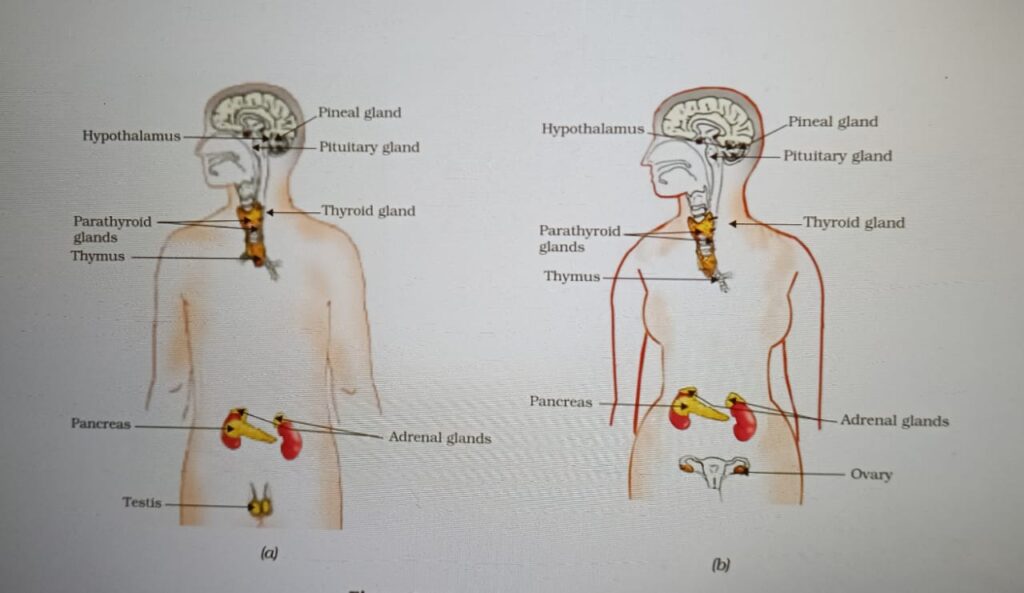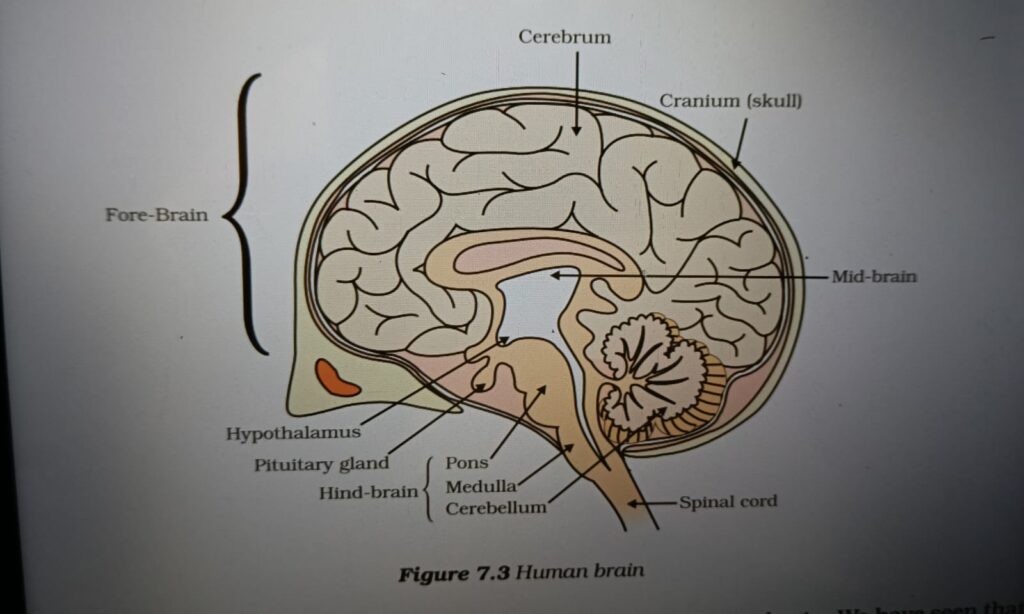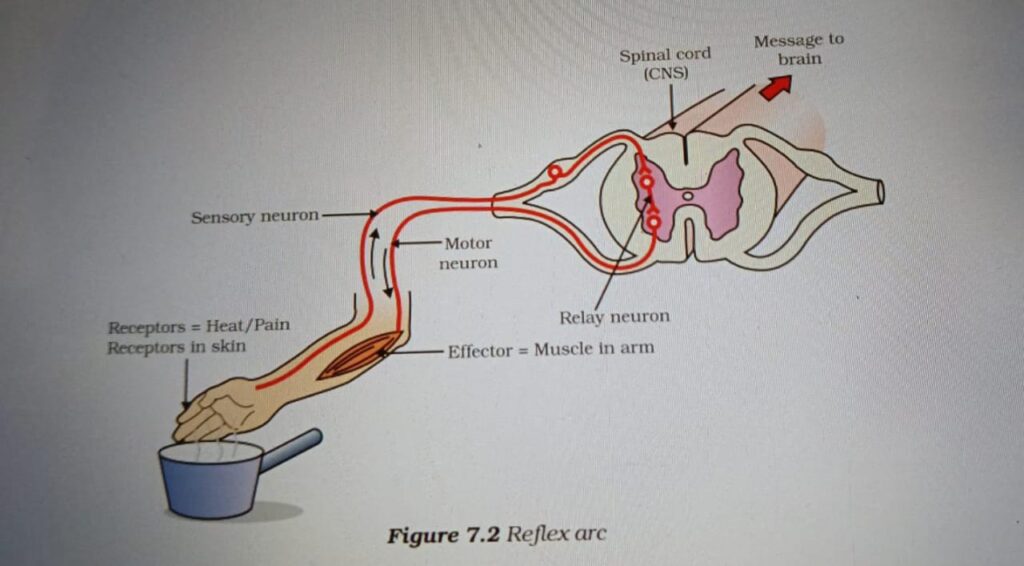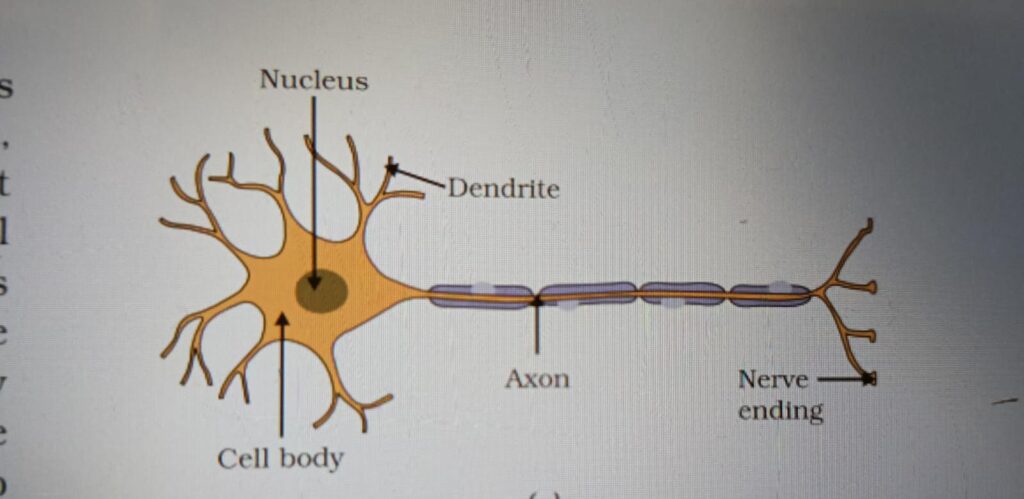Endocrine Glands
- Produce hormone
- ductless glands
- directly secrete hormones into blood stream
- It help in control and coordination
Exocrine Glands
- produce enzyme
- have ducts to store enzymes
- stored in glands and transported when required
- it helps in digestion
Q. Name the gland associated with kidney.
Ans. Adrenal gland
Q. Name a gland which which secrete both enzymes and hormones.
Ans. Pancrease
Q. Write functions of thyroxine hormone.
Ans. Thyroxine is secreted by thyroid gland. Thyroxine regulates carbohydrate, protein and fat metabolism in the body so as to provide the best balance for growth. Iodine is essential for the synthesis of thyroxin. Iodine is necessary for the thyroid gland to makethyroxin hormone. In case iodine is deficientin our diet, there is a possibility that we might suffer from goitre. One of the symptoms in this disease is a swollen neck.
Q. Write function of growth hormone.
Ans. Growth Hormone is secreted by pituitary gland. growth hormone regulates growth and development ofthe body. If there is a deficiency of this hormone in childhood, it leads to dwarfism. Excess secretion of growth hormone lead to giantism.
Q. ) Write note on:
- Adrenaline hormone
- Oestrogen Hormone
- Testosterone hormone
Ans. 1. Adrenaline Hormone: Secreted by adrenal gland. Also known as fear hormone. In case of fear or stress adrenal gland secrete adrenaline hormone directly into blood hear which increase the heart beat. Increased hear rate also increase the oxygen supply to different body parts. Breathing rate also increases because of the contractions of the diaphragm and the rib muscles. All these responses together enable the animal body to be ready to deal with the situation.
2. Oestrogen Hormone: Secreted by ovary of female. Bring secondary sexual characters in female.
3. Testosterone hormone: Secreted by testes of male. Bring secondary sexual characters in male.
Q, Explain feedback mechanism.
Ans. The timing and amount of hormone released are regulated by feedback mechanisms. For example, if the sugar levels in blood rise, they are detected by thecells of the pancreas which respond by producing more insulin. As the blood sugar level falls, insulin secretion is reduced.
Note: Insulin hormone is secreted by pancreas. In control sugar level in the blood.
ENDOCRINE SYSTEM IN HUMAN:

Q. Write function of different parts of brain.
Ans.
Cerebrum ( fore brain):
main thinking part of brain, site of calculation, memory, feeling of fullness as it site for hunger. It is site for smell and site.
Medula
All involuntary actions including blood pressure, salivation and vomiting are controlled by the medulla in the hind-brain.
Cerebellum: It is responsible for precision of voluntary actions and maintaining the posture and balance of the body. example:-walking in a straight line, riding a bicycle,picking up a pencil. These are possible due to cerebellum.
Diagram of brain:

Q. How brain and spinal chord are protected?
Ans. Brain: brain sits in a bony box called skull or cranium. Cranium protect brain from external injury. Inside the box, the brain is contained in a fluid-filled balloon which provides further shock absorption. The fluid is called cerebro spinal fluid.
spinal chord: vertebral column or back bone protect spinal chord from external injury. Cerebro spinal fluid absorb the shock waves.
Q. Define reflex action and reflex arc.
Ans. Relex action: sudden action in the response to stimuli is called reflex action. Eg. Iris contracts in response to bright light.
Reflex Arc: The.pathway of Reflex action is called Reflex arc. Effected part>Sensory neuron>spinal chord(relay neuron)>motor neuron>effectors

Q. What is synapse?
Ans. Gap between two neuron is called synapse.
Q. Explain working of neuron.
Ans,

information, acquired at the end of the dendritic tip of a nerve cell, sets off a chemical reaction that creates an electrical impulse. This impulse travels from the dendrite to the cell body, and then along the axon to it send. At the end of the axon, the electrical impulse sets off the release of some chemicals. These chemicals cross the gap, or synapse, and start a similar electrical impulse in a dendrite of the next neuron.
Compare Reflex Action and coordination through brain
Reflex action
- control by spinal chord
- simple process
- take less time
- most widely spreader that means reflex action shown bt even microbes and bacteria which lack brain.
Coordination through brain
- control by brain itself
- a complex process
- take more time
- found in only complex organism
Q.) List phyto/plant hormones and their function.
Ans.
- Auxin: It is a growth hormone. It helps cells to grow longer. It synthesised near shoot tip.
- Gibberellins: It is a growth hormone. It helps in the growth of the stem.
- Cytokinins: It helps in cell division. So found in greater concentration in areas of rapid cell division. Such as fruit and seed.
- abscisic Acid: It inhibit growth in plants. It causes wilting of leaves.
- ethylene: it help in ripening of fruits.
Q. Define tropic movement. Write examples.
Ans. Directional movement or bending of plant in response to light, water , chemicals etc are called tropic movement. These movements help plants grow and develop, and protect them from sudden changes.
Examples:
| Phototropism | Plants grow towards light, with stems growing towards the light and roots growing away from it. |
| geotropism | Plants grow in response to gravity, with roots growing towards gravity (+ve geotropism) and stems growing away from it (-ve). |
| Chemotropism | Pollen grains move towards ovums through pollen tube in response to a chemical substance released by the ovum. |
| Thigmotropism | Plants grow or develop in response to contact with a solid object. Tendrils show this type of movement. |
| Hydrotropism | Plants grow towards water, with roots growing towards water and stems growing away from it. For example, plant roots grow towards areas with higher humidity |
| Thermotropism | Plants grow towards atmospheric temperature, with stems growing towards it and roots growing away from it. |
Q.Explain nastic movement.
Ans. Nastic movement is a non-growth movement in plants that occurs in response to stimuli, but is not related to the direction of the stimulus. These movements are usually associated with flat plant parts, such as leaves or flower petals. Ex. Contraction of plant 🍃 leaves in touch-me-not (chuimui-mimosa family) in response to touch.
Q. Explain movement of tendrils.
Ans. The movement of tendrils is called thigmotropism, which is a directional growth movement in response to touch. Thigmotropism: When a tendril tip touches a support, the cells on opposite sides of the tendril grow (due to hormone auxin) in a directional way, causing the tendril to coil around the support.
Q. Explain phototropism.
Ans. When growing plants detect light, a hormone called auxin, synthesised at the shoot tip, helps the cells to grow longer. When light is coming from one side of the plant, auxin diffuses towards the shady side of the shoot. This concentration of auxin stimulates the cells to grow longer on the side of the shoot which is away from light. Thus, the plant appears to bend towards light.
Extra Reading…(not for examination)
Introduction to Control and Coordination
Control and coordination in biological systems are vital processes that enable organisms to respond to environmental stimuli. At the forefront of these processes are hormone reflexes and the functionality of the brain, which work in harmony to ensure that living beings can adapt to changes both internal and external. This article delves into the intricacies of these mechanisms in both animals and plants.
The Role of Hormones in Coordination
Hormones serve as chemical messengers that play a pivotal role in control and coordination, especially in multicellular organisms. They help regulate various physiological processes including growth, metabolism, and mood, by transmitting signals from one part of the body to another. This intricate dance of hormonal communication is essential for maintaining homeostasis and permitting reflex actions in response to stimuli.
Brain Functionality and Reflex Actions
The brain functions as the central hub for control and coordination, processing sensory information and initiating responses swiftly. Reflex actions, governed by neural pathways, bypass the cognitive centers of the brain for faster reactions to potentially harmful stimuli. This ensures that organisms can respond to their environment in a timely manner, reflecting the brain’s remarkable ability to maintain coordination across various bodily systems.
Coordination in Plants
Interestingly, control and coordination are not limited to animals; plants also possess sophisticated mechanisms to respond to their surroundings. Through growth hormones such as auxins and gibberellins, plants adjust their growth patterns and trajectories in response to light, gravity, and mechanical stimulation. This fascinating example underscores the universality of control and coordination across different life forms.